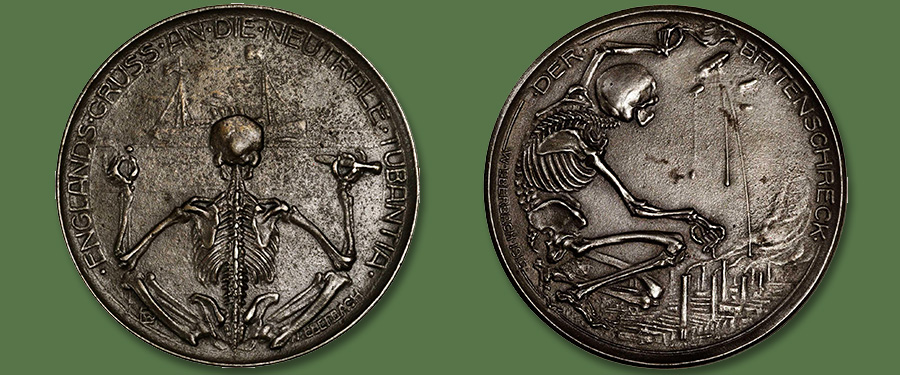
As the first great conflict to serve as a focal point for much of the world, it is not surprising that World War I is commemorated by means of medallic art. The countries on each side, whether the allies or the central powers, issued medals ranging from poignant to propagandistic. Solemn reflections upon lives lost and towns ravaged were commonplace, as were images of force and strength—even if not entirely accurate; the narrative, after all, was that which was most vital. Medals of a satirical nature also found their way into this unfolding storyline of the Great War, with designs by the famed Karl Goetz leading the way. Being German, Goetz’s medals often portrayed the enemies of his fatherland in a less-than-flattering light, often comically so. One of this most famous (or infamous) pieces—one which shockingly poked fun at the sinking of the Lusitania and her many lives lost—garnered so much attention that the British even copied it, utilizing the proceeds garnered from sales to assist the families of the tragedy. While Goetz’s design featured a skeleton at a ticket booth, gleefully (and morbidly) selling passes to the doomed travelers, it was another series entirely that fully embraced the macabre, painting a grim, satirical portrait.
The Totentanz or “dance of death” is an allegorical take on the universality of death that originated in the middle ages. Though compositions such as vanitas or memento mori were meant to reflect upon the dual nature of life and death (pairing aspects of living with a skull, for example) the Totentanz instead plays a different note. In this vein, German medalist Walther Eberbach produced a series of large, cast iron medals evoking this very sentiment—seemingly lighthearted yet also incredibly heavy and powerful at the same time. Dealing mostly with naval engagements and tragedies at sea, this series presents a skeleton (representing death) in various poses, usually sadistically taking pleasure in the mishaps encountered by the enemy allied forces. This frank morbidity was expressed by Eberbach himself in a letter to Julius Menadier, in which he wrote “…I want whoever holds the pieces in their hands years later to be overcome by shudder grimness.” When viewing these medals, it’s safe to say that, in this desire, Eberbach was astoundingly successful.





